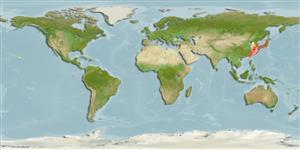Environment: milieu / climate zone / depth range / distribution range
Ecologia
marinhas demersal; oceanódromo (Ref. 51243); intervalo de profundidade ? - 100 m. Subtropical; 46°N - 20°N, 116°E - 153°W
Northwest Pacific: Japan and the eastern Korean Peninsula to the Hawaiian Islands.
Tamanho / Peso / Idade
Maturity: Lm ? range ? - ? cm
Max length : 150 cm TL macho/indeterminado; (Ref. 9988); peso máx. Publicado: 40.0 kg (Ref. 9988)
Descrição breve
Chaves de identificação | Morfologia | Morfometria
Espinhos dorsais (total) : 6 - 7; Raios dorsais moles (total) : 29 - 36; Espinhos anais: 3; Raios anais moles: 17 - 22; Vértebras: 24. Scutes absent. Compared to S. lalandi, the species' dorsoposterior corner of upper jaw is angular (versus rounded) and the pectoral and pelvic fins are almost equal in length (versus pectoral shorter than pelvic fin).
Adults exhibit shoaling habit (Ref. 9988). They feed on plankton. Juveniles are found among floating seaweeds (Ref. 12114, 12115). Collection of young is the basis for prosperous aquaculture in Japan. Raised in captivity and marketed fresh for sashimi (Ref. 9988).
Life cycle and mating behavior
Maturities | Reprodução | Spawnings | Egg(s) | Fecundities | Larvas
Robins, C.R., R.M. Bailey, C.E. Bond, J.R. Brooker, E.A. Lachner, R.N. Lea and W.B. Scott, 1991. World fishes important to North Americans. Exclusive of species from the continental waters of the United States and Canada. Am. Fish. Soc. Spec. Publ. (21):243 p. (Ref. 4537)
Categoria na Lista Vermelha da IUCN (Ref. 130435)
Ameaça para o homem
Harmless
Utilização humana
Pescarias: altamente comercial; Aquacultura: espécies comerciais; peixe desportivo: sim
Ferramentas
Relatórios especiais
Descarregue XML
Fontes da internet
Estimates based on models
Phylogenetic diversity index (Ref.
82804): PD
50 = 0.5020 [Uniqueness, from 0.5 = low to 2.0 = high].
Bayesian length-weight: a=0.01413 (0.00618 - 0.03226), b=2.94 (2.74 - 3.14), in cm total length, based on LWR estimates for this (Sub)family-body shape (Ref.
93245).
Nível Trófico (Ref.
69278): 4.0 ±0.65 se; based on food items.
Generation time: 3.4 ( na - na) years. Estimated as median ln(3)/K based on 1
growth studies.
Resiliência (Ref.
120179): Médio, tempo mínimo de duplicação da população 1,4 - 4,4 anos (K=0.3-0.5).
Prior r = 0.57, 95% CL = 0.38 - 0.85, Based on 1 data-limited stock assessment.
Fishing Vulnerability (Ref.
59153): Moderate to high vulnerability (52 of 100).
Climate Vulnerability (Ref.
125649): Very high vulnerability (100 of 100).
Nutrients (Ref.
124155): Calcium = 52.4 [32.1, 127.7] mg/100g; Iron = 1.36 [0.76, 2.65] mg/100g; Protein = 18.9 [16.0, 21.8] %; Omega3 = 0.334 [0.213, 0.557] g/100g; Selenium = 37.3 [19.1, 79.6] μg/100g; VitaminA = 17.4 [2.2, 126.7] μg/100g; Zinc = 0.428 [0.301, 0.639] mg/100g (wet weight);
